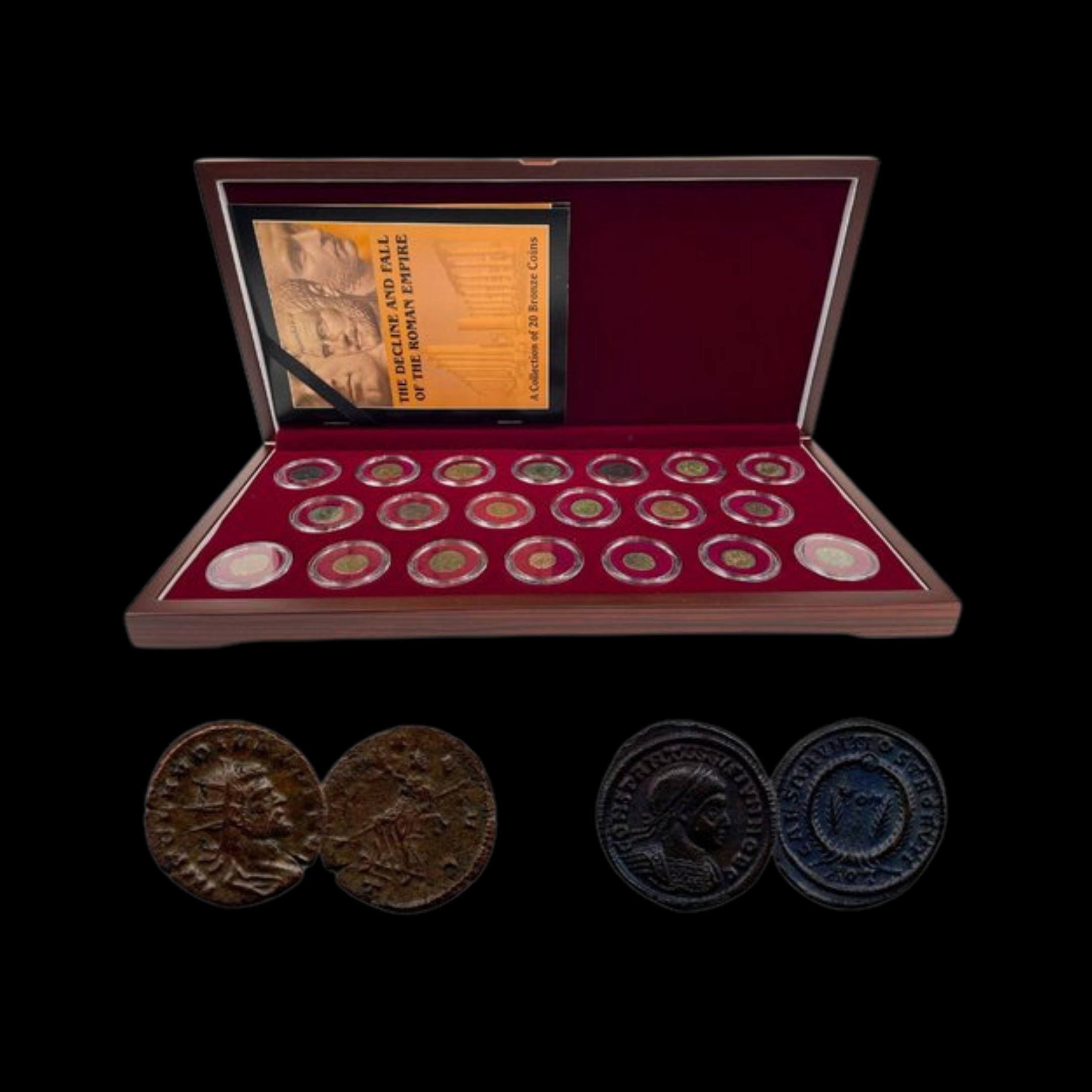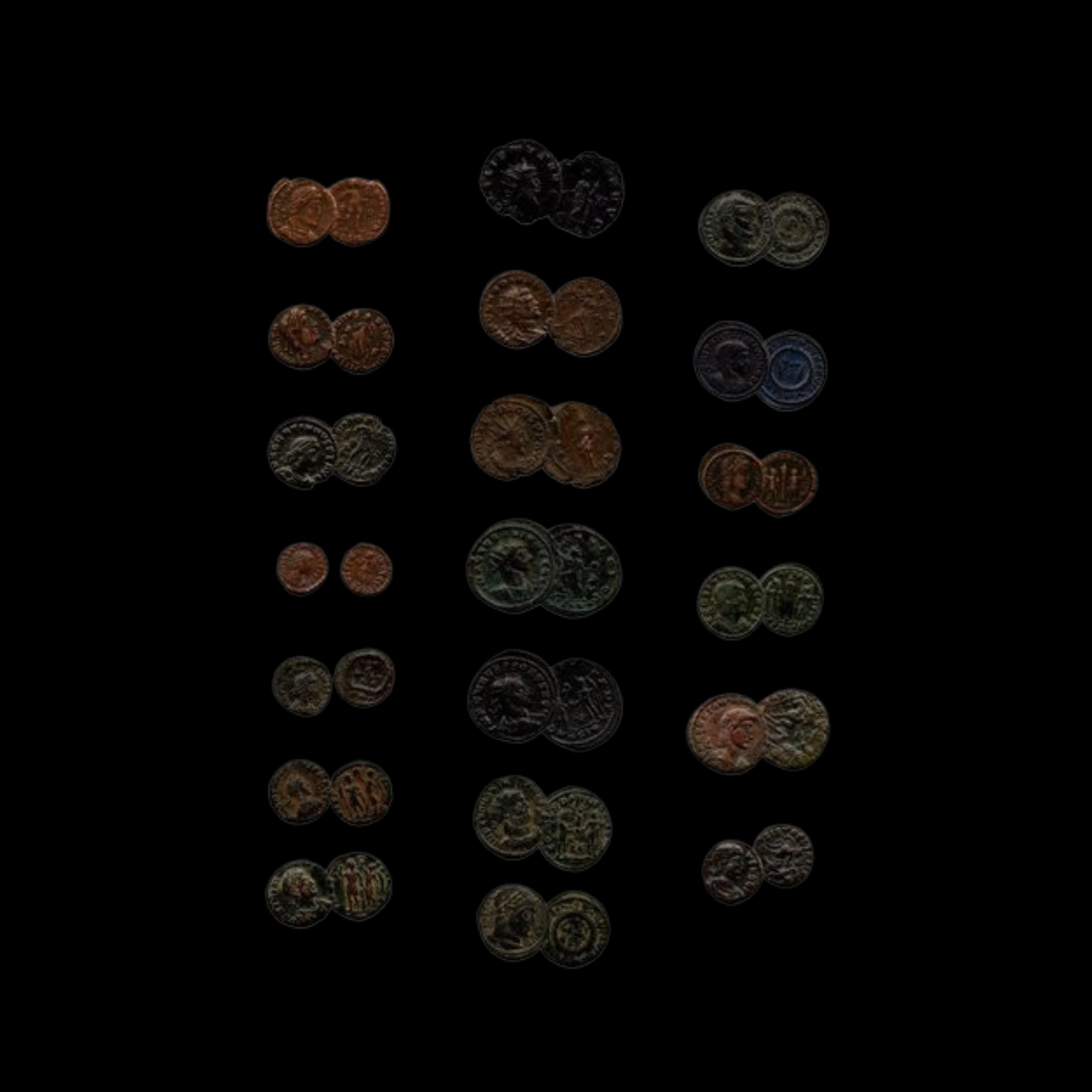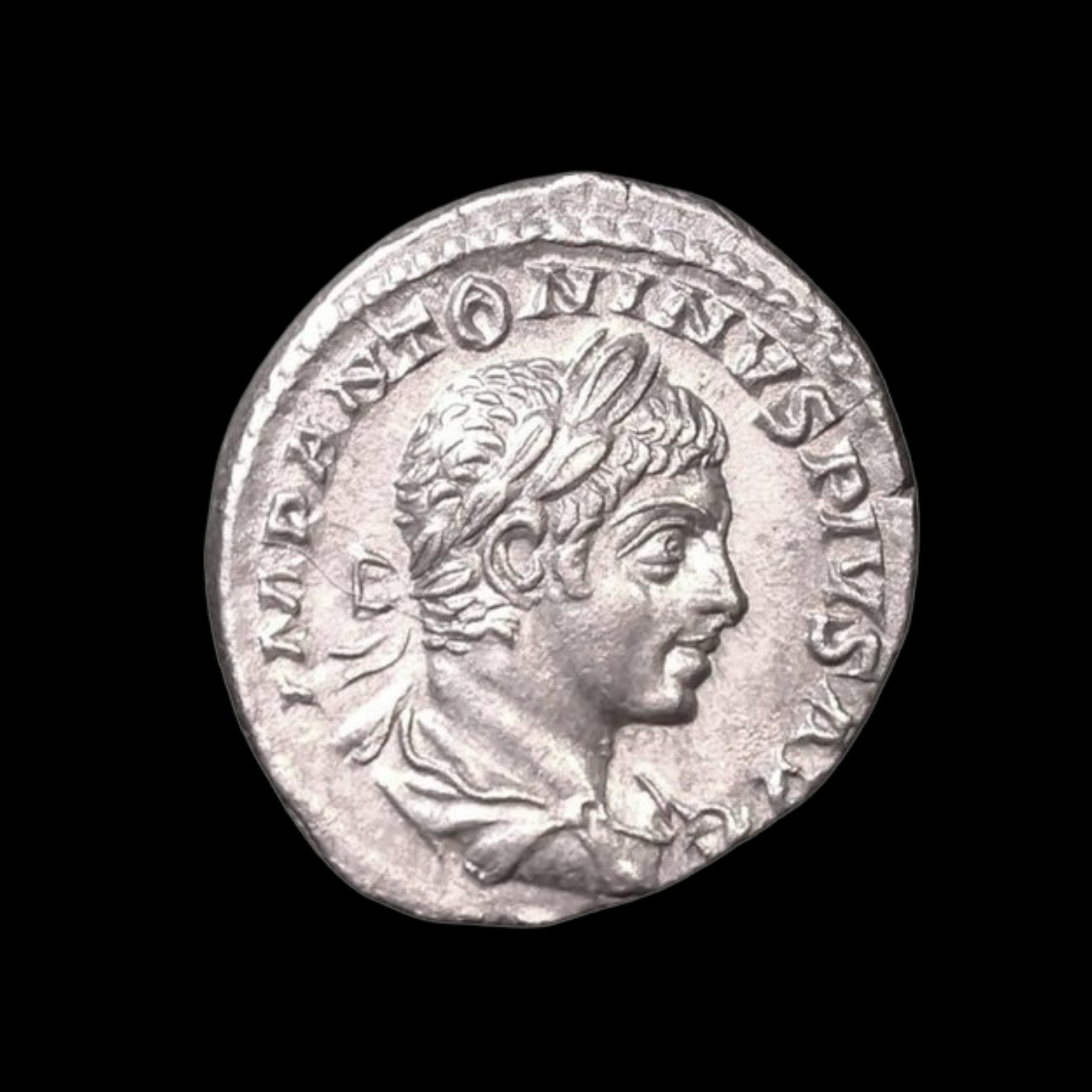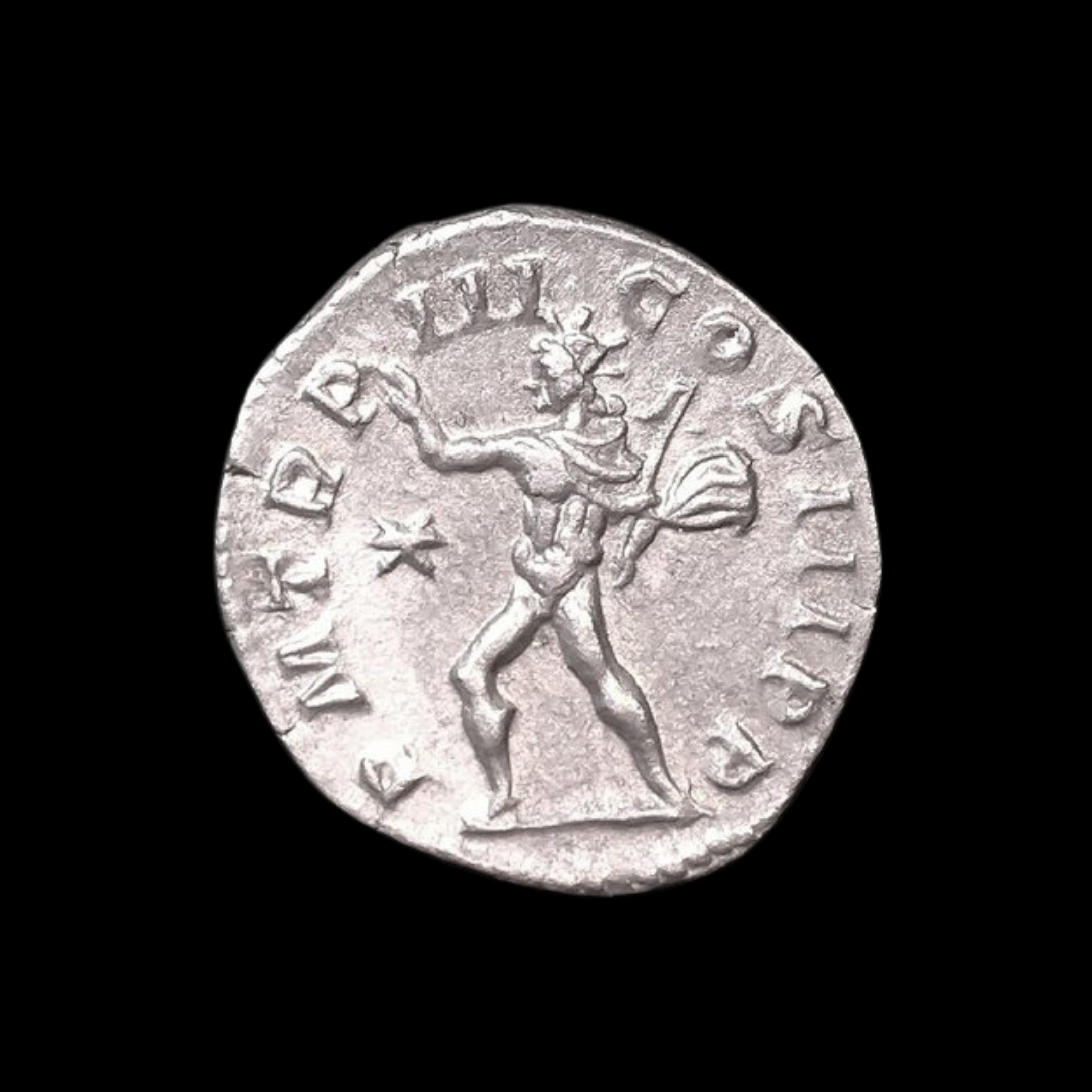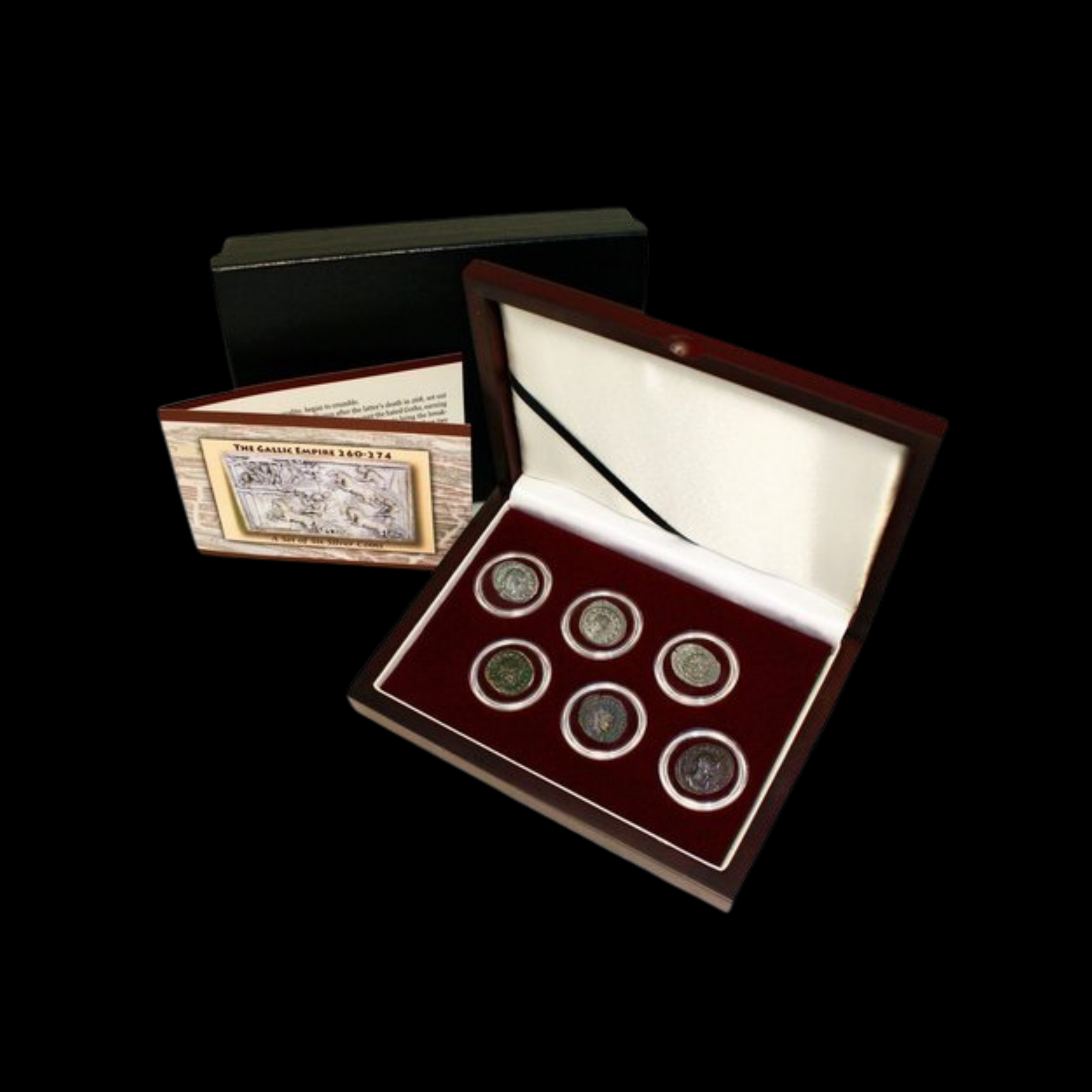 Image 1 of 3
Image 1 of 3

 Image 2 of 3
Image 2 of 3

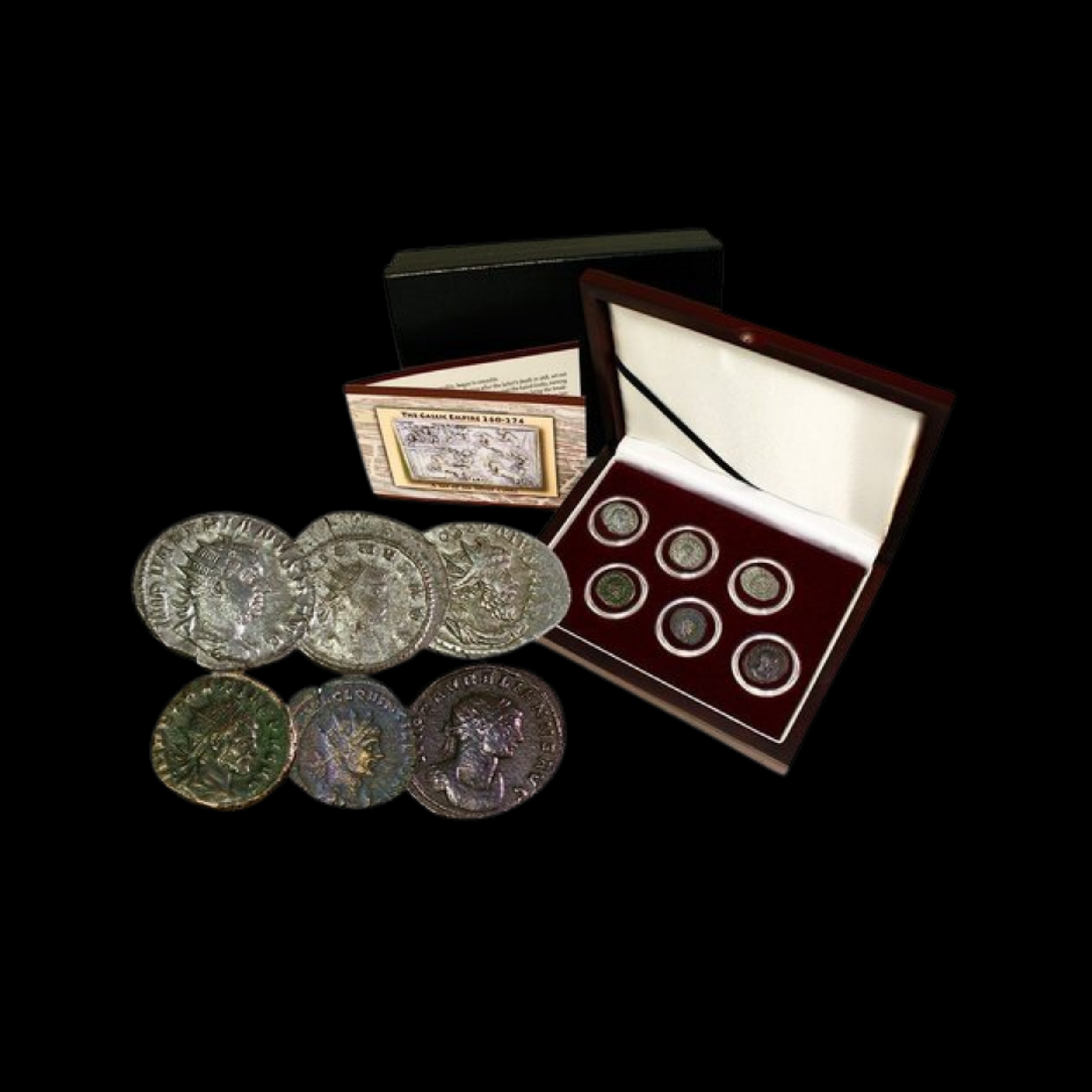 Image 3 of 3
Image 3 of 3




The Fracture of Imperial Rome: Gallic Empire Six-Coin Collection
This fascinating collection features six authentic coins from one of Rome's most turbulent periods, the Crisis of the Third Century (235-284 AD). During this time, the Roman Empire fractured into three competing states, with the Gallic Empire breaking away in the west. This collection includes coins from four Roman emperors during this chaotic era, plus the founder of the breakaway Gallic Empire and his successor.
1. Valerian I Antoninianus (about 1765 years ago)
This silver-washed bronze coin was minted under Emperor Valerian I, whose catastrophic capture by the Persians accelerated the empire's crisis and led to the formation of breakaway states.
Coin Description:
Front side: Portrait of Valerian I wearing a radiate crown, facing right, with Latin inscription of his titles
Back side: Likely depicts a Roman deity such as Jupiter, Apollo, or Victoria (Victory), or military symbols representing imperial power
Technical Details:
Billon composition (silver-washed bronze)
Denomination: Antoninianus (double denarius)
Date: 253-260 AD
Historical Significance: Valerian's reign marked a critical turning point in Roman history. His capture by Sassanid Persian forces in 260 AD (the first Roman emperor ever taken prisoner) created a power vacuum that allowed generals in the provinces to declare independence. This humiliation weakened central Roman authority and directly contributed to the empire's fragmentation into three competing states.
2. Gallienus Antoninianus (about 1760 years ago)
This coin was issued by Gallienus, son of Valerian, who ruled alone after his father's capture and faced the impossible task of holding the empire together.
Coin Description:
Front side: Portrait of Gallienus wearing a radiate crown, typically with the inscription "GALLIENUS AUG" or similar titles
Back side: Commonly features animals (Gallienus was known for coins depicting creatures associated with various deities) or military/religious symbols
Technical Details:
Billon composition (decreasing silver content during his reign)
Denomination: Antoninianus
Date: 260-268 AD
Historical Significance: Gallienus ruled during the height of the Crisis of the Third Century, when the empire fractured into three parts. Despite military reforms that strengthened the cavalry and created a more mobile defense force, he was unable to prevent the Gallic Empire's secession in the west and the Palmyrene Empire's formation in the east. His assassination in 268 AD further destabilized the central Roman government.
3. Postumus Antoninianus (about 1760 years ago)
This coin was issued by Postumus, the military commander who broke away from Rome to establish the independent Gallic Empire in 260 AD.
Coin Description:
Front side: Portrait of Postumus with radiate crown and beard, typically with inscription proclaiming him as emperor
Back side: Often features Hercules (Postumus associated himself with this deity) or personifications of virtues like Peace, Victory, or Prosperity
Technical Details:
Billon composition (often higher quality than contemporary Roman issues)
Denomination: Antoninianus
Date: 260-269 AD
Historical Significance: Postumus established the breakaway Gallic Empire in 260 AD, controlling Gaul (modern France), Germania (Germany), Britannia (Britain), and Hispania (Spain). Unlike many usurpers, he never attempted to conquer Rome itself, instead focusing on defending his territories against Germanic tribes. His coins were often of better quality than those of the central empire, reflecting his attempt to establish legitimacy for his regime.
4. Victorinus Antoninianus (about 1755 years ago)
This coin was minted under Victorinus, the second emperor of the Gallic Empire who succeeded Postumus after his assassination.
Coin Description:
Front side: Portrait of Victorinus with radiate crown and short beard, with imperial titles
Back side: Commonly features personifications such as Pax (Peace), Salus (Health), or Providentia (Foresight), or military symbols
Technical Details:
Billon composition
Denomination: Antoninianus
Date: 269-271 AD
Historical Significance: Victorinus ruled the Gallic Empire for just two years following Postumus's assassination. Despite his short reign, he maintained the independence of the western provinces against both Germanic invaders and attempts by the central Roman Empire to reclaim these territories. His own assassination in 271 AD began the decline of the Gallic Empire, which would be reabsorbed into the Roman Empire by 274 AD.
5. Claudius II Gothicus Antoninianus (about 1755 years ago)
This coin was issued by Claudius II (Gothicus), who briefly stabilized the central Roman Empire and began the process of reunification.
Coin Description:
Front side: Portrait of Claudius II with radiate crown, typically clean-shaven or with short beard
Back side: Often features military themes, Victory, or deities like Jupiter, Mars, or Apollo
Technical Details:
Billon composition
Denomination: Antoninianus
Date: 268-270 AD
Historical Significance: Claudius II succeeded Gallienus as central Roman Emperor and earned the title "Gothicus" for his victories against Gothic invaders. His brief but effective reign began to restore Rome's fortunes after years of crisis. Although he died of plague after just two years in power, his military successes laid the groundwork for the eventual reunification of the empire under Aurelian.
6. Aurelian Antoninianus (about 1750 years ago)
This coin was minted under Emperor Aurelian, the "Restorer of the World," who successfully reunited the Roman Empire by defeating both the Gallic and Palmyrene breakaway states.
Coin Description:
Front side: Portrait of Aurelian with radiate crown and typically a stern expression, with imperial titles
Back side: Often features the inscription "RESTITVTOR ORBIS" (Restorer of the World) or similar themes of renewal and victory
Technical Details:
Billon composition (with Aurelian's monetary reforms increasing metal content)
Denomination: Antoninianus (reformed by Aurelian)
Date: 270-275 AD
Historical Significance: Aurelian reunited the Roman Empire by defeating the Palmyrene Empire in 272 AD and the Gallic Empire in 274 AD, ending the imperial fracture. His currency reforms attempted to restore confidence in Roman coinage after decades of debasement. Despite his assassination in 275 AD, Aurelian's five-year reign was crucial in saving the Roman Empire from complete dissolution, earning him the title "Restorer of the World."
This fascinating collection features six authentic coins from one of Rome's most turbulent periods, the Crisis of the Third Century (235-284 AD). During this time, the Roman Empire fractured into three competing states, with the Gallic Empire breaking away in the west. This collection includes coins from four Roman emperors during this chaotic era, plus the founder of the breakaway Gallic Empire and his successor.
1. Valerian I Antoninianus (about 1765 years ago)
This silver-washed bronze coin was minted under Emperor Valerian I, whose catastrophic capture by the Persians accelerated the empire's crisis and led to the formation of breakaway states.
Coin Description:
Front side: Portrait of Valerian I wearing a radiate crown, facing right, with Latin inscription of his titles
Back side: Likely depicts a Roman deity such as Jupiter, Apollo, or Victoria (Victory), or military symbols representing imperial power
Technical Details:
Billon composition (silver-washed bronze)
Denomination: Antoninianus (double denarius)
Date: 253-260 AD
Historical Significance: Valerian's reign marked a critical turning point in Roman history. His capture by Sassanid Persian forces in 260 AD (the first Roman emperor ever taken prisoner) created a power vacuum that allowed generals in the provinces to declare independence. This humiliation weakened central Roman authority and directly contributed to the empire's fragmentation into three competing states.
2. Gallienus Antoninianus (about 1760 years ago)
This coin was issued by Gallienus, son of Valerian, who ruled alone after his father's capture and faced the impossible task of holding the empire together.
Coin Description:
Front side: Portrait of Gallienus wearing a radiate crown, typically with the inscription "GALLIENUS AUG" or similar titles
Back side: Commonly features animals (Gallienus was known for coins depicting creatures associated with various deities) or military/religious symbols
Technical Details:
Billon composition (decreasing silver content during his reign)
Denomination: Antoninianus
Date: 260-268 AD
Historical Significance: Gallienus ruled during the height of the Crisis of the Third Century, when the empire fractured into three parts. Despite military reforms that strengthened the cavalry and created a more mobile defense force, he was unable to prevent the Gallic Empire's secession in the west and the Palmyrene Empire's formation in the east. His assassination in 268 AD further destabilized the central Roman government.
3. Postumus Antoninianus (about 1760 years ago)
This coin was issued by Postumus, the military commander who broke away from Rome to establish the independent Gallic Empire in 260 AD.
Coin Description:
Front side: Portrait of Postumus with radiate crown and beard, typically with inscription proclaiming him as emperor
Back side: Often features Hercules (Postumus associated himself with this deity) or personifications of virtues like Peace, Victory, or Prosperity
Technical Details:
Billon composition (often higher quality than contemporary Roman issues)
Denomination: Antoninianus
Date: 260-269 AD
Historical Significance: Postumus established the breakaway Gallic Empire in 260 AD, controlling Gaul (modern France), Germania (Germany), Britannia (Britain), and Hispania (Spain). Unlike many usurpers, he never attempted to conquer Rome itself, instead focusing on defending his territories against Germanic tribes. His coins were often of better quality than those of the central empire, reflecting his attempt to establish legitimacy for his regime.
4. Victorinus Antoninianus (about 1755 years ago)
This coin was minted under Victorinus, the second emperor of the Gallic Empire who succeeded Postumus after his assassination.
Coin Description:
Front side: Portrait of Victorinus with radiate crown and short beard, with imperial titles
Back side: Commonly features personifications such as Pax (Peace), Salus (Health), or Providentia (Foresight), or military symbols
Technical Details:
Billon composition
Denomination: Antoninianus
Date: 269-271 AD
Historical Significance: Victorinus ruled the Gallic Empire for just two years following Postumus's assassination. Despite his short reign, he maintained the independence of the western provinces against both Germanic invaders and attempts by the central Roman Empire to reclaim these territories. His own assassination in 271 AD began the decline of the Gallic Empire, which would be reabsorbed into the Roman Empire by 274 AD.
5. Claudius II Gothicus Antoninianus (about 1755 years ago)
This coin was issued by Claudius II (Gothicus), who briefly stabilized the central Roman Empire and began the process of reunification.
Coin Description:
Front side: Portrait of Claudius II with radiate crown, typically clean-shaven or with short beard
Back side: Often features military themes, Victory, or deities like Jupiter, Mars, or Apollo
Technical Details:
Billon composition
Denomination: Antoninianus
Date: 268-270 AD
Historical Significance: Claudius II succeeded Gallienus as central Roman Emperor and earned the title "Gothicus" for his victories against Gothic invaders. His brief but effective reign began to restore Rome's fortunes after years of crisis. Although he died of plague after just two years in power, his military successes laid the groundwork for the eventual reunification of the empire under Aurelian.
6. Aurelian Antoninianus (about 1750 years ago)
This coin was minted under Emperor Aurelian, the "Restorer of the World," who successfully reunited the Roman Empire by defeating both the Gallic and Palmyrene breakaway states.
Coin Description:
Front side: Portrait of Aurelian with radiate crown and typically a stern expression, with imperial titles
Back side: Often features the inscription "RESTITVTOR ORBIS" (Restorer of the World) or similar themes of renewal and victory
Technical Details:
Billon composition (with Aurelian's monetary reforms increasing metal content)
Denomination: Antoninianus (reformed by Aurelian)
Date: 270-275 AD
Historical Significance: Aurelian reunited the Roman Empire by defeating the Palmyrene Empire in 272 AD and the Gallic Empire in 274 AD, ending the imperial fracture. His currency reforms attempted to restore confidence in Roman coinage after decades of debasement. Despite his assassination in 275 AD, Aurelian's five-year reign was crucial in saving the Roman Empire from complete dissolution, earning him the title "Restorer of the World."
This fascinating collection features six authentic coins from one of Rome's most turbulent periods, the Crisis of the Third Century (235-284 AD). During this time, the Roman Empire fractured into three competing states, with the Gallic Empire breaking away in the west. This collection includes coins from four Roman emperors during this chaotic era, plus the founder of the breakaway Gallic Empire and his successor.
1. Valerian I Antoninianus (about 1765 years ago)
This silver-washed bronze coin was minted under Emperor Valerian I, whose catastrophic capture by the Persians accelerated the empire's crisis and led to the formation of breakaway states.
Coin Description:
Front side: Portrait of Valerian I wearing a radiate crown, facing right, with Latin inscription of his titles
Back side: Likely depicts a Roman deity such as Jupiter, Apollo, or Victoria (Victory), or military symbols representing imperial power
Technical Details:
Billon composition (silver-washed bronze)
Denomination: Antoninianus (double denarius)
Date: 253-260 AD
Historical Significance: Valerian's reign marked a critical turning point in Roman history. His capture by Sassanid Persian forces in 260 AD (the first Roman emperor ever taken prisoner) created a power vacuum that allowed generals in the provinces to declare independence. This humiliation weakened central Roman authority and directly contributed to the empire's fragmentation into three competing states.
2. Gallienus Antoninianus (about 1760 years ago)
This coin was issued by Gallienus, son of Valerian, who ruled alone after his father's capture and faced the impossible task of holding the empire together.
Coin Description:
Front side: Portrait of Gallienus wearing a radiate crown, typically with the inscription "GALLIENUS AUG" or similar titles
Back side: Commonly features animals (Gallienus was known for coins depicting creatures associated with various deities) or military/religious symbols
Technical Details:
Billon composition (decreasing silver content during his reign)
Denomination: Antoninianus
Date: 260-268 AD
Historical Significance: Gallienus ruled during the height of the Crisis of the Third Century, when the empire fractured into three parts. Despite military reforms that strengthened the cavalry and created a more mobile defense force, he was unable to prevent the Gallic Empire's secession in the west and the Palmyrene Empire's formation in the east. His assassination in 268 AD further destabilized the central Roman government.
3. Postumus Antoninianus (about 1760 years ago)
This coin was issued by Postumus, the military commander who broke away from Rome to establish the independent Gallic Empire in 260 AD.
Coin Description:
Front side: Portrait of Postumus with radiate crown and beard, typically with inscription proclaiming him as emperor
Back side: Often features Hercules (Postumus associated himself with this deity) or personifications of virtues like Peace, Victory, or Prosperity
Technical Details:
Billon composition (often higher quality than contemporary Roman issues)
Denomination: Antoninianus
Date: 260-269 AD
Historical Significance: Postumus established the breakaway Gallic Empire in 260 AD, controlling Gaul (modern France), Germania (Germany), Britannia (Britain), and Hispania (Spain). Unlike many usurpers, he never attempted to conquer Rome itself, instead focusing on defending his territories against Germanic tribes. His coins were often of better quality than those of the central empire, reflecting his attempt to establish legitimacy for his regime.
4. Victorinus Antoninianus (about 1755 years ago)
This coin was minted under Victorinus, the second emperor of the Gallic Empire who succeeded Postumus after his assassination.
Coin Description:
Front side: Portrait of Victorinus with radiate crown and short beard, with imperial titles
Back side: Commonly features personifications such as Pax (Peace), Salus (Health), or Providentia (Foresight), or military symbols
Technical Details:
Billon composition
Denomination: Antoninianus
Date: 269-271 AD
Historical Significance: Victorinus ruled the Gallic Empire for just two years following Postumus's assassination. Despite his short reign, he maintained the independence of the western provinces against both Germanic invaders and attempts by the central Roman Empire to reclaim these territories. His own assassination in 271 AD began the decline of the Gallic Empire, which would be reabsorbed into the Roman Empire by 274 AD.
5. Claudius II Gothicus Antoninianus (about 1755 years ago)
This coin was issued by Claudius II (Gothicus), who briefly stabilized the central Roman Empire and began the process of reunification.
Coin Description:
Front side: Portrait of Claudius II with radiate crown, typically clean-shaven or with short beard
Back side: Often features military themes, Victory, or deities like Jupiter, Mars, or Apollo
Technical Details:
Billon composition
Denomination: Antoninianus
Date: 268-270 AD
Historical Significance: Claudius II succeeded Gallienus as central Roman Emperor and earned the title "Gothicus" for his victories against Gothic invaders. His brief but effective reign began to restore Rome's fortunes after years of crisis. Although he died of plague after just two years in power, his military successes laid the groundwork for the eventual reunification of the empire under Aurelian.
6. Aurelian Antoninianus (about 1750 years ago)
This coin was minted under Emperor Aurelian, the "Restorer of the World," who successfully reunited the Roman Empire by defeating both the Gallic and Palmyrene breakaway states.
Coin Description:
Front side: Portrait of Aurelian with radiate crown and typically a stern expression, with imperial titles
Back side: Often features the inscription "RESTITVTOR ORBIS" (Restorer of the World) or similar themes of renewal and victory
Technical Details:
Billon composition (with Aurelian's monetary reforms increasing metal content)
Denomination: Antoninianus (reformed by Aurelian)
Date: 270-275 AD
Historical Significance: Aurelian reunited the Roman Empire by defeating the Palmyrene Empire in 272 AD and the Gallic Empire in 274 AD, ending the imperial fracture. His currency reforms attempted to restore confidence in Roman coinage after decades of debasement. Despite his assassination in 275 AD, Aurelian's five-year reign was crucial in saving the Roman Empire from complete dissolution, earning him the title "Restorer of the World."












